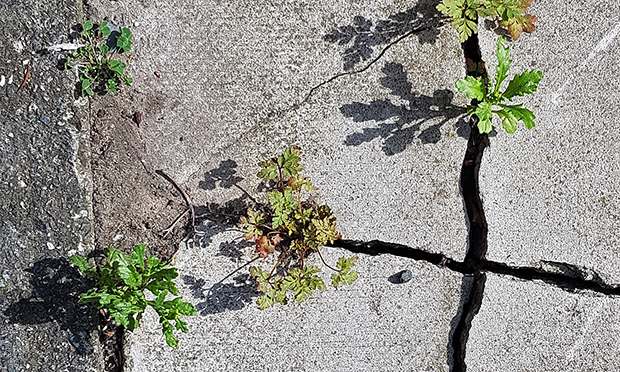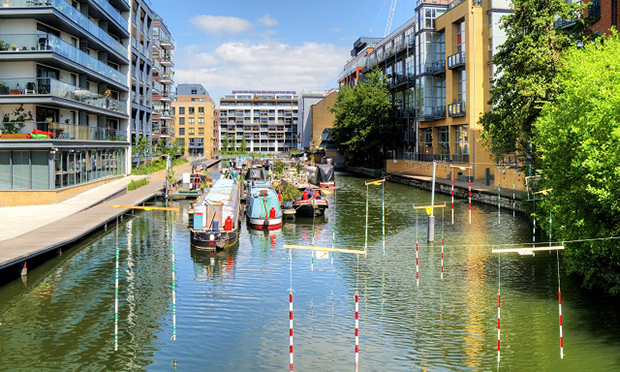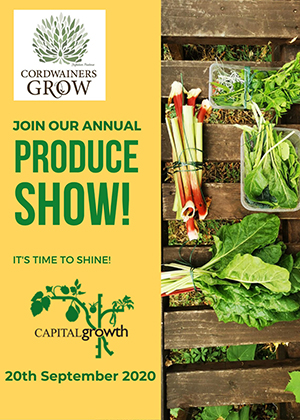The Citizen Gardener: Contested Spaces

I saw a Twitter spat recently between ‘tree’ people and ‘meadow’ people when the government announced that they would plant more trees (and reduce the amount of meadowland).
There was a of lot of aggravation between them but they were both right: trees are important and meadows are important. They were forced to contest a space for wildlife. But once the tree or meadow people have won that space, how should it be managed?
The death of many newly-planted trees on Hackney Marshes made me think again about the best approach to dealing with the two emergencies of climate change and wildlife depletion in our contested spaces.
In the 10xGreener area in E5, the neighbourhood’s efforts to green up have coincided with the council stopping spraying herbicides. This means that plants are allowed to move naturally in the spaces that they ‘want’ to occupy because there are the right levels of light and nutrients for them. These plants are the most successful because they are specialised for the particular environment and have ‘chosen’ their space. They don’t need watering or feeding. Some will become permanent. Others will die back and be replaced.
We have found scores of varieties of plants growing in the cracks and margins, and it seems most people are happy for them to stay. They enhance the streets and us and seldom do harm.
Among the wild plants are garden escapees like red valerian, pansies and violets and then true wild flowers like hawk’s beard, cranesbill, mouse ear, prickly ox tongue and other animal-like plants. In one small patch we identified 42 species of wild flower.
This variety is vital for wildlife; it ensures that there are a succession of flowers at different times of year and that there are different sorts of flowers for a range of insects (which then, of course, become food for larger insects and animals).
We can plant and sow particular varieties we want to encourage and which we hope will thrive, but the ones that do best are those that find their own way there.
There is a theory that, rather than plant trees, we should just allow scrub to grow naturally – and perhaps import some hooved animals to keep a check on it. How would everyone feel about pigs, cows, ponies and deer on Hackney Marshes?
Planning
Another contested space is building for housing or green space.
A new development has recently been approved on Kingsland Basin, despite a large amount of opposition and evidence that it will be detrimental to local wildlife.
Residents had taken years to provide the habitat and conditions that it needs so now there are nesting swans, bats, spawning fish and a visiting kingfisher.

The Town Hall’s planning committee, though, ignored respected environmental organisations and allowed the development to go through, even though it has no social housing included. The committee’s decision-making is often opaque and it takes a lot of time and commitment to challenge plans. Us Nimbys (as they view us, though a Nimby is often just someone fighting for their local neighbourhood) seem to be besieged by big developments that ignore local and environmental concerns. More than 80 per cent of them are approved.
But the government wants to make it easier to get plans through. There is a new consultation on planning out. It’s 84 pages long and calls for an overhaul of the current system which, it claims, is inefficient, old fashioned, complex and opaque.
It says consultations are dominated by the few willing or able to navigate the process and that there is not enough focus on design resulting in not enough good housing being built. This rings true. What they say they will do is get communities involved earlier in the process, have more engagement with the Local Plans which will divide land into three categories: Renewal, Protected, Growth. Basically, this means most land is fine for development except that which is designated protected for environmental or cultural reasons.
Once those zones have been designated, buildings will be given automatic approval in growth zones and in renewal zones given permission in principle. They want smaller developments exempt from providing social housing, they want everything digitised (which ignores the digital divide that has become evident in the last months), and it’s unclear how the environment will fare as they are removing environmental impact assessments.
Critics like RIBA say it will be a licence to built slums. The scheme reduces public scrutiny and I wonder, where space is so contested in urban areas, how any of it will be designated protected for the environment? It doesn’t seem practical in somewhere like Hackney where, presumably, only parks, marshes and wetlands can be preserved – not all the small spaces on or around estates or little corners of greenery on the margins that are so important as wildlife corridors for example.
I’m still working my way through the document but I urge you to fill out the long and tedious and self-congratulatory consultation, mainly because I think they assume we won’t have the time, inclination or will to. You can find it at bit.ly/3bh1obS.
How They Made Us Doubt Everything
Climate change is still contested by some, though something like 99 per cent of scientists think that the warming of the planet is because of human activity.
This podcast, How They Made Us Doubt Everything, is essential listening for anyone wondering why more people don’t take climate change seriously (and who want to be surprised by how low powerful companies will go to protect their interests – at the expense of all of us).
The series shows that in the 1980s, 80 per cent of the US public was concerned about man-made climate change compared to less than half now, and how this change in public opinion happened. It shows how the fossil fuel industry used (and uses) the same tactics as the tobacco manufacturers did in denying and perverting the evidence of harm (of cancer or rising temperatures) by undermining scientists, changing the narrative and manipulating us to doubt scientific research – and making it a matter of identity, not fact.
It was illuminating to hear conservative politicians like George Bush and Margaret Thatcher in the 80s acknowledge the harm that human-induced climate change would do.
Bush talked about the Earth speaking back to us because of our activities. He promised to tackle the greenhouse effect with the White House effect, while Margaret Thatcher spoke of an insidious danger: “It is mankind and his activities which are changing the environment of our planet in damaging and dangerous ways.”
This concern about the environment was a worry to the fossil fuel companies. International moves like the Kyoto Protocol, and the public support for it, were threats to their existence. So representatives from oil companies like Exxon, climate sceptic scientists (who said rising temperatures were a blip in the sun’s energy and not to do with human activity) and think tanks got together a multi-million dollar plan to sow doubt.
They wanted to reverse and divert attention given to the science. Their strategy to gain victory would be achieved when average citizens and the media understood and recognised uncertainties in climate science, and unless climate change became a non-issue, there would be no moment when “we can declare victory”.
So their job is to undermine science. They train(ed) and fund(ed) their own scientists and in the 1990s started a relentless campaign to move, in the public’s eye, the science from fact to theory. They knew that the best group to target was older, lesser educated white males and make it a question not of science, but of conservative and even sexual identity to them (fossil fuels = masculine, powerful; renewable energy = weak). They put flamboyant showmen with little regard for facts up against dull, precise scientists on the television and dismissed and minimised the evidence.
Over the last thirty or so years, they succeeded in producing a narrative of uncertainty and distrust of science which remains.
Listen to the podcast at bbc.in/32Kccvc.
Virtual produce show

And finally, a more good-natured contest.
In the absence of 3D annual veg and produce shows, Capital Growth, Social Farms and Gardens, including Hackney City Farm and Cordwainers Grow, are putting on a virtual show over the weekend of 19-20 September – find out more at bit.ly/31PWNKp.
Cordwainers will also be live streaming snail races so email hello@cordwainersgrow.org.uk if you’d like to take part.
Kate Poland is an award-winning community gardener and the UK’s first ever postcode gardener in E5. For more, head to cordwainersgrow.org.uk and friendsoftheearth.uk
